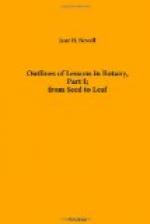[Footnote 1: See the stipules of the Pea, p. 31.]
[Illustration: FIG. 15.—Copper Beech. 1. Branch in winter state: a, leaf-scar; b, bud-scar. 2. Branch, with leaf-buds expanding, showing the plicate folding of the leaves.]
The leaf-scars are small, soon becoming merely ridges running half round the stem.
The bud-rings are very plain and easily counted. For this reason, and because it branches freely, it is a good tree for measurements of growth, as is seen in the following tables. Nos. 1, 2, 3 and 4: were made by a class of girls, from fourteen to sixteen, from a tree on my lawn. No. 5 was made by a pupil, whom I taught by correspondence, from a tree of the same species in another town. No. 6 was made by myself from my own tree. The measurements of the first four tables were somewhat revised by me, as they were not perfectly accurate. The pupils should always be cautioned to measure from the beginning of one set of rings to the beginning of the next.[1]
[Footnote 1: Care must be taken to select branches well exposed to the light. Of course there are many circumstances that may aid or hinder the growth of any particular branch.]
NO. 1.
YEARS. GROWTH OF 1ST BRANCH. 2nd BRANCH. 3RD BRANCH 4TH BRANCH. MAIN AXIS. ------------------------------------------------------------
---- in. ’79 8-1/2 — — — — ’80 4-1/2 2 1-7/8 — — ’81 3-1/2 1-1/8 2-5/8 — — ’82 6 5/8 4-1/4 5-7/8 — ’83 7-3/8 3-3/8 5-1/4 4 5-3/4 ’84 2 1/2 3/4 3/8 5-3/8 ’85 5/8 1/4 3/8 1/2 1 ’86 5-5/8 7/8 4-3/8 3-1/8 5




